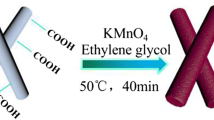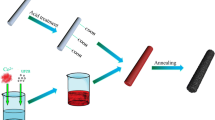Abstract
The carbon fiber (CF) is frequently preferred because it is considered as a multifunctional lightweight composite, where the CF is not only acted as one completely integrated part of the device with high-performance structural reinforcement, but also served as one of the battery electrode to storage energy. However, the limitation of electrochemical capacity of commercial CFs for the structural lithium-ion battery (SLIB) is an urgent issue should be solved. Therefore, in this work, a novel strategy to fabricate CF@SnO2 composite is developed by employing one-step tin tetrachloride solvothermal method. The performance of the CFs could be improved by growing the stannic oxide firmly on each CF to form a synergetic electrode. When tested as anode materials, a high reversible capacity of 510 mAh g−1 at a current density of 100 mAh g−1 is maintained without obvious decay up to 150 cycles (a huge increase as high as 637.5% than that of the pure CFs). Furthermore, our strategy reveals an attainable route, which could be as a promising way to make a sustainable anode for SLIBs and carbon-based multi-functional composite for other practical applications.






Similar content being viewed by others
References
Tarascon JM, Armand M (2001) Issues and challenges facing rechargeable lithium batteries. Nature 414(6861):359–367
Etacheri V, Marom R, Elazari R, Salitra G, Aurbach D (2011) Challenges in the development of advanced Li-ion batteries: a review. Energy Environ Sci 4(9):3243–3262
Dunn B, Kamath H, Tarascon JM (2011) Electrical energy storage for the grid: a battery of choices. Science 334(6058):928–935
Lou XW, Archer LA, Yang Z (2008) Hollow micro-/nanostructures: synthesis and applications**. Adv Mater 20(21):3987–4019
Fan L, Zhang Y, Zhang Q et al (2016) Graphene aerogels with anchored sub-micrometer mulberry-like ZnO particles for high-rate and long-cycle anode materials in lithium ion batteries. Small 12(37):5208–5216
Liu P, Sherman E, Jacobsen AJ (2009) Design and fabrication of multifunctional structural batteries. J Power Sources 189(1):646–650
Jacques E, Lindbergh G, Zenkert D, Leijonmarck S, Kjell MH (2015) Piezo-electrochemical energy harvesting with lithium-intercalating carbon fibers. ACS Appl Mater Interfaces 7(25):13898–13904
Kjell MH, Zavalis TG, Behm M, Lindbergh G (2013) Electrochemical characterization of lithium intercalation processes of PAN-based carbon fibers in a microelectrode system. J Electrochem Soc 160(9):A1473–A1481
Jacques E, Kjell MH, Zenkert D, Lindbergh G (2014) The effect of lithium-intercalation on the mechanical properties of carbon fibres. Carbon 68:725–733
Jacques E, Kjell MH, Zenkert D, Lindbergh G, Behm M, Willgert M (2012) Impact of electrochemical cycling on the tensile properties of carbon fibres for structural lithium-ion composite batteries. Compos Sci Technol 72(7):792–798
Kjell MH, Jacques E, Zenkert D, Behm M, Lindbergh G (2011) PAN-based carbon fiber negative electrodes for structural lithium-ion batteries. J Electrochem Soc 158(12):A1455–A1460
Fan L, Li B, Rooney DW et al (2015) In situ preparation of 3D graphene aerogels@ hierarchical Fe 3 O 4 nanoclusters as high rate and long cycle anode materials for lithium ion batteries. Chem Commun 51(9):1597–1600
Fang W, Zhang N, Fan L et al (2016) Bi 2 O 3 nanoparticles encapsulated by three-dimensional porous nitrogen-doped graphene for high-rate lithium ion batteries. J Power Sources 333:30–36
Park M, Wang G, Kang Y, Wexler D, Dou SX, Liu H (2007) Preparation and electrochemical properties of SnO2 nanowires for application in lithium-ion batteries. Angew Chem 46(5):750–753
Chen JS, Lou XW (2013) SnO2-based nanomaterials: synthesis and application in lithium-ion batteries. Small 9(11):1877–1893
Wang X, Zhou X, Yao K, Zhang J, Liu Z (2011) A SnO2/graphene composite as a high stability electrode for lithium ion batteries. Carbon 49(1):133–139
Huang G, Zhang F, Du X, Qin Y, Yin D, Wang L (2015) Metal organic frameworks route to in situ insertion of multiwalled carbon nanotubes in Co3O4 polyhedra as anode materials for lithium-ion batteries. ACS Nano 9(2):1592–1599
Zhang Y, Hu Z, Liang Y, Yang Y, An N, Li Z et al (2015) Growth of 3D SnO 2 nanosheets on carbon cloth as a binder-free electrode for supercapacitors. J Mater Chem A 3(29):15057–15067
Cong HP, Xin S, Yu SH (2015) Flexible nitrogen-doped graphene/SnO 2 foams promise kinetically stable lithium storage. Nano Energy 13:482–490
Yi Z, Han Q, Zan P, Cheng Y, Wu Y, Wang L (2016) Facile fabrication of SnO2@TiO2 core–shell structures as anode materials for lithium-ion batteries. J Mater Chem 4(33):12850–12857
Yao J, Shen X, Wang B, Liu H, Wang G (2009) In situ chemical synthesis of SnO2―graphene nanocomposite as anode materials for lithium-ion batteries. Electrochem Commun 11(10):1849–1852
Eom W, Kim A, Park H, Kim H, Han TH (2016) Graphene-mimicking 2D porous Co3O4 nanofoils for lithium battery applications. Adv Funct Mater 26(42):7605–7613
Poizot P, Laruelle S, Grugeon S, Dupont L, Tarascon J (2000) Nano-sized transition-metal oxides as negative-electrode materials for lithium-ion batteries. Nature 407(6803):496–499
Acknowledgements
This project was supported by University Nursing Program for Young Scholars with Creative Talents in Heilongjiang Province (UNPYSCT-2015114), the Creative Research Groups of the National Natural Science Foundation of China (Grant No. 21521092), the National Science Foundation of China (Project No. 51475207), the China Postdoctoral Science Foundation (Grant No. 2015m580253), and the Postdoctoral Foundation of Jilin Province.
Author information
Authors and Affiliations
Corresponding authors
Electronic supplementary material
ESM 1
(DOCX 386 kb)
Rights and permissions
About this article
Cite this article
Han, Q., Wang, F., Wang, Z. et al. PAN-based carbon fiber@SnO2 for highly reversible structural lithium-ion battery anode. Ionics 24, 1049–1055 (2018). https://doi.org/10.1007/s11581-017-2261-0
Received:
Revised:
Accepted:
Published:
Issue Date:
DOI: https://doi.org/10.1007/s11581-017-2261-0




